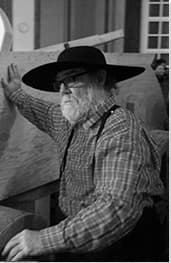Summary of Paul McCarthy
Paul McCarthy is one of America's most provocative and influential contemporary artists. Taking his early cue from pioneers of Performance Art, such as Joseph Beuys and Allan Kaprow, McCarthy went on to build his reputation on a series of visceral and lewd (some would say, tasteless) works. McCarthy's oversized and overblown projects take from the worlds of film and television, literature, fine art, politics, and philosophy to build their withering critiques of consumer society. His readiness to embrace cultural taboos, such as bodily fluids, sadomasochism, and coprophilia, have seen McCarthy compared to his contemporary, Matthew Barney. Creating controversy, however, has never been McCarthy's primary objective. Indeed, the artist does not see himself as a dissident figure at all, but rather another byproduct of the damaged society that his art routinely confronts. Perhaps McCarthy's overarching achievement has been to produce art that is unwieldly and transgressive, but also commercially lucrative.
Accomplishments
- McCarthy, who used his art to, in his words, "expose the interior of the body", became associated with the theme of body abjection. In early video performances such as Heinz Ketchup/Sauce (1974) he smeared his body in ketchup, mustard, and mayonnaise to imitate bodily fluids. In one respect these performances were part of a wider movement in body art, but McCarthy differed from contemporaries like of Chris Burden, Vito Acconci, and Carolee Schneemann, in the way his performances were less about self and identity, and more about social satire, parody, and subversion.
- McCarthy has showed concern about the conditioning children. For his series, Apple Tree Boy Apple Tree Girl (2010), for example, he took the innocent German rosy-cheeked porcelain figure of the "Hummel" and reworked it into something much more insidious. By distorting such benign emblems of childhood, McCarthy found a way to deliver a biting critique of the state's manipulation of children and blurred the lines between the Hitler youth, Walt Disney, and children's television.
- Through their thinly veiled references to sex toys, McCarthy's most provocative civic sculptures, Santa Claus (2001), and Tree (2014), have delivered an afront to public taste. To the innocent eye the sculptures were "just trees", but to the many who took offense, the works offered a blunt reminder of the thin divide between private and public life.
- McCarthy engaged in a series of three improvisational performances with the German actress, Lilith Stangenberg. In their last collaboration, A&E (2020), the pair moved between their real identities and those of Adolf Hitler and Eva Braun and Adam and Eve. While the project/s addressed some of the artist's thematic preoccupations (sadomasochism and psychological control) A&E was also about finding new levels of artistic improvisation. Indeed, while deep in the throes of the couple's entangled performances, McCarthy produced a series of impulsive works that he called entries into "the other world" that existed outside the performance.
The Life of Paul McCarthy
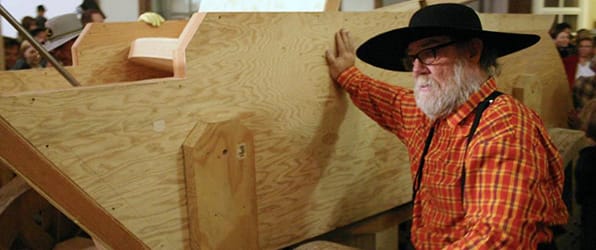
Curator M. Petersens writes, "McCarthy's oeuvre draws from politics and popular culture to investigate themes of sexuality, death and cultural subconscious. From performances incorporating bodily fluids and foods to elaborately staged installations and drawings executed by the artist's alter egos, McCarthy's works confront the human capacity for ugliness".
Important Art by Paul McCarthy
Heinz Ketchup/Sauce
This early video performance announced McCarthy's radical engagement with the body, abjection, and his intent to deconstruct consumer culture. In Heinz Ketchup/Sauce, McCarthy uses ketchup, mustard, and other sauces as substitutes for bodily fluids, smearing them across his own body in an unsettling and grotesque manner. The composition of the video recording is stark and intimate, placing McCarthy in a faintly-lit, confined space, hunched over a table covered in food stuffs and substances. The low-quality, grainy texture, of the video, combined with its unfiltered aesthetic, adds to the feeling of discomfort and distortion. The presence of a Heinz ketchup bottle, a symbol of processed American food, further adds to the artist's uncomfortable fusion of consumption, bodily degradation, and spectacle that defines much of his work.
The work emerged from the 1970s Performance Art movement, a time when artists such as Chris Burden, Vito Acconci and Carolee Schneemann were using their bodies as mediums for extreme expressions of self, power and vulnerability. McCarthy's work shares similarities with these artists but diverges in its explicitly grotesque and satirical approach. The choice of Heinz ketchup, a universal food product, reinforces his fascination with the banal and the grotesque, turning an everyday condiment into an element of psychological discomfort. Furthermore, ketchup is synonymous with American fast-food dining. For McCarthy, who said, "I had this thing about exposing the interior of the body", it becomes symbolic of blood and features in several future works.
Video (color and sound) - Museum of Modern Art, New York
Painter
Painter is a satire that deconstructs the myth of the heroic artist and the ideological weight of painting, all the while exposing the greed of the art world and its obsession with being at the "cutting edge" of society. Set in a theatrical studio and bedroom that resemble a TV soap opera, the video features McCarthy in the role of the painter. Dressed in an oversized artist's smock, tinted with colors, a blonde wig and grotesque prosthetics - including a comically large bulbous nose, disproportionately oversized ears, and exaggerated clown-like hands that distort natural proportions - McCarthy's character is a parody of the male artistic genius and his excesses. Accompanied by a gallerist and collectors, the painter becomes consumed by fetishistic behaviors, financial concerns and social validation, turning the act of painting into an absurd performance. Oversized brushes, giant tubes of paint and jars of mayonnaise and sauce blur the line between art and bodily consumption, reinforcing the ritualistic and performative aspects of painting.
In the video, the painter mutters and rambles, his actions merging painting with food preparation, both of which take on sexual connotations. In one scene, McCarthy spins while chanting "de Kooning", a reference to the Abstract Expressionist master whose legend is based on that of the quintessential solitary genius. McCarthy's grotesque and disheveled caricature of the painter aims to dismantle this over-romanticized and heroic version of the groundbreaking male Abstract Expressionists.
According to the Hauser & Wirth gallery, McCarthy's work is "rooted in the tradition of parody and subversion, drawing inspiration from pre-modern carnival culture. His use of grotesque imagery exaggerated bodily performances, crude humor, and obscene language reflects the carnivalesque, a concept developed by Russian philosopher and literary critic Mikhail Bakhtin. Bakhtin viewed carnival as a space where societal norms were temporarily overturned, allowing for the mockery and inversion of power structures through humor and chaos. Originally a critique of totalitarianism in the 1930s, Bakhtin's ideas found renewed significance during the countercultural movements of the 1960s, inspiring artistic expressions of rebellion, nonconformity, and anti-authoritarianism".
Video, projection or monitor (colour and sound) - Tate London
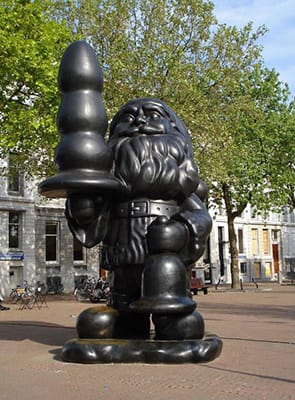
Santa Claus
Santa Claus, more commonly referred to as Gnome Buttplug, is a bronze sculpture that subverts the traditional imagery of Santa Claus. It features a jolly, rotund Santa holding an object that could be a Christmas tree but much more closely resembles a "buttplug" sex aid. Originally commissioned by the Museum Boijmans Van Beuningen, it was intended for Rotterdam's Coolsingel, a prominent shopping district, but following a public backlash it was rejected by city officials. As curator Dick van Teilingen, writes, "Some found [Santa Claus] tasteless and offensive, while others considered that a hypocritical point of view in an era permeated by commercial sex. Is this élite taste terrorism, or should art stimulate the debate? [The] sculpture has been shifted from one location to another in the city like a hot potato. In the end Museum Boijmans Van Beuningen offered it a haven [...] It is to be hoped that one day, it will be given a location in a busy shopping street".
As with much of McCarthy's works, Santa Claus distorts seemingly innocuous commercialized icons, revealing the underlying absurdities and contradictions embedded in them. Santa, a figure associated with joy, generosity, and childhood wonder, is transformed here into a crude caricature, thereby questioning the commodification of holiday traditions and their ties to capitalism, desire, and fetishism. Despite the public skepticism, however, many have praised McCarthy's sculpture. Artist Rachel Harrison, for instance, admires the ingenuity in McCarthy's incongruous (and eccentric) formal juxtapositions, and the way they illuminate contemporary political and cultural issues. Indeed, Harrison sees a real purpose behind such lewd absurdity, stating that "it's impossible to activate this material without [...] formal intelligence".
Statue - Rotterdam, Eendrachtsplein
Paul Dreaming, Vertical, Horizontal
Paul Dreaming, Vertical, Horizontal is a life-sized, hyperrealistic sculpture. McCarthy's uncanny self-portrait is crafted from platinum silicone and features the artist's partially clothed body reclining on a padded lawn chair. The sculpture, which evokes a scene reminiscent of a quiet backyard moment, is undercut by the figure's exposed lower half (including its flaccid penis). The meticulous attention to detail, from the texture of the skin to the folds in the clothing, are clearly intended to blur the line between art and reality. Originally cast in 2005, the standing figure (which explains the flat feet) was intended as a prop for one of McCarthy's films but it remained in storage until 2012. The vertical (standing)/horizontal (reclining) comparison could invite questions about consciousness and unconsciousness, or of life and death, and the caprices that separate these states. Here, the casual staging underlines the banality of the scene, possibly making the exploration of the theme life and death theme more prescient.
The sculpture formed part of the collection at the Glenstone Museum in Potomac, Maryland, and was featured in The Metropolitan Museum of Art's exhibition "Like Life: Sculpture, Color, and the Body" in 2018. The Met said of the piece: "McCarthy explores the potential of the surrogate figure - an inanimate object with human characteristics - as a means of visualizing subjective experience and confronting mortality". Art critic Taylor Dafoe commented, "McCarthy's silicone cast of his own person feels most realistic - so much so, in fact, that one is almost wary in getting close to it, afraid that the figure could open its eyes at any moment. [...] Many of McCarthy's works tap into the absurd, the gross, or the just plain weird, but Paul Dreaming, in its exacting replication of the 60-year-old artist's body, reads as a portrait of a man reconciling himself with the decay of his body, and confronting his own mortality".
Platinum silicone, clothing, plastic, foam, lawn chair - Glenstone Museum, Maryland
Apple Tree Boy Apple Tree Girl
Apple Tree Boy Apple Tree Girl (in recognition of the Adam and Eve myth) forms part of a series of works influenced by German "Hummels". These were small porcelain figurines of rosy-cheeked young children, placed in idyllic pastoral settings, and based on the early 20th century drawings of Sister Maria Innocentia Hummel. Cast in aluminum from 3D scans, McCarthy's sculptures stand at an imposing five meters tall, their sandblasted and waxed surface contrasting sharply with the delicate porcelain of the originals.
McCarthy exaggerates the figures' proportions, twisting them into freakish forms. Their features and warped bodies challenge nostalgic sentimentality, and the commercialization of childhood. By distorting and reshaping of these innocuous German dolls, McCarthy presents a critique of the historically sanitized portrayal of childhood. First exhibited at L&M Arts Gallery in Los Angeles in 2011, they were then featured in London's Sculpture in the City (an annual sculpture park that uses the urban realm as a rotating gallery space) exhibition in 2017, next to works by the likes of Damien Hirst and Daniel Buren. Displayed in this urban setting, the sculptures were in the best place to engage the public, and to ask them to contemplate the role such toys play in the social conditioning of children.
Art critic Nick Turpin commented, "In McCarthy's world, this Aryan naïveté becomes a target for parody, and ultimately, defilement and disfigurement. The figures deformed innocence suggests the conditioning of children, from Hitler youths to contemporary, TV-addled teen consumers. The miniature Adam and Eve find themselves reborn as 18 foot Überkinder; they remain only a suggestion of their former selves, sweetly deformed to the point of abstraction. The implicit naïveté of the Hummel motif is materially deconstructed, portraying a sophisticated fall from grace for these darling figures, in simultaneously literal and metaphorical terms".
Cast aluminum, sandblasted, waxed - L&M Arts Gallery, Los Angeles
A&E
A&E was the third collaboration between McCarthy and the prominent German theater actress, Lilith Stangenberg. The pair had first performed together on an installation/video project called Rebel Dabble Babble in 2016, and then, in 2019, on a filmed performance called NV Night Vater. All three projects are linked through themes of sexual control, sadomasochism, and fascistic power relations, and improvised and interchanging role play. As McCarthy states, "The title A&E is an abbreviation of Adolf [Hitler] and Eva [Braun] and also of Adam and Eve, two cultural cliché polarities. A&E can also stand for 'arts and entertainment.' All three references function as human cultural signifiers".
For the first incarnation of A&E (the pair would later adapt it for a live audience) McCarthy and Stangenberg undertook two filmed sessions, each lasting several days. New York's Hauser & Wirth gallery describes these sessions as, "Performance intertwined with drawing and painting, then further intertwined with documentation and filmmaking that leads back to drawing and painting [forming] an obsessive mis-en-abyme [a narrative technique that embeds a story within another story] layering of work that becomes performative in itself". For McCarthy, the A&E sessions were the closest he had come to a fully immersive artistic experience, the resultant drawings capturing the anger and spontaneity of the pairs' "shape-shifting" performances. Indeed, McCarthy explained that his drawings were created on a large platform that doubled as a stage for the performers' improvised performances. McCarthy added that in creating these drawings during the performance, he had created a series of "automatic" images he could have never produced otherwise.
In 2022, McCarthy and Stangenberg presented A&E to a live performance (in Hamburg and Vienna). Donatien Grau, Head of Contemporary Programmes at the Musée du Louvre, wrote, "the performance is not presented frontally to viewers, but rather staged in a complex display feature. The actions are blocked to direct viewing by a camera-telescoping crane set on tracks moving back and forth in front of the set of rooms - which itself sits on a rotating turntable. The video recordings are edited instantly [and] released on two large screens mounted above the stage. Thus we see what is happening on stage as a live-action and as a two-channel projection rather than a traditional theatrical performance". Grau added that McCarthy and Stangenberg "dig into the underbelly of our conventions, and show us physical violence, language broken into stammers, and two human beings at war, and in love. They recreate a ritual, reinventing what catharsis once was - towards our times. What they do has the density of the masterpiece, while being sabotaged all the way. It is, simply put, life".
Performance, film, painting, drawing, sculpture, and sound - Hauser & Wirth, New York
Biography of Paul McCarthy
Childhood

Paul McCarthy was born in 1945 in Salt Lake City (SLC), the capital of Utah. During the mid-19th century members of the Church of Jesus Christ of Latter-Day Saints (Mormon) religion migrated from the Midwest to the city. Despite such strong religious associations, McCarthy has remarked that growing up in SLC felt to him no different from life in any other American city. McCarthy's mother was, however, a devout Mormon, although his father maintained only loose ties to the faith. McCarthy insists that religion had little influence on his early upbringing. For their part, his parents fully encouraged their son's artistic leanings and supported his decision to attend art school.
Early Training and Work
McCarthy graduated from Weber State College, Ogden, in 1965. He moved to the University of Utah where he studied painting. However, McCarthy felt constrained by the art faculty's strong focus on classicism. Nevertheless, it was at this time that MacCarthy created his so-called Black Paintings (1966-67). These pieces, painted on wooden door panels laid flat on the floor, saw the artist apply his thick black paint with a rag. He then beat the wooden door with a hammer (or like tool) before dousing it in gasoline and setting it on fire. McCarthy then buried the works (given the political climate in which they were produced, some commentators have read the Black Paintings as a statement on the Vietnam war). McCarthy completed the last year of his undergraduate studies at the San Francisco Art Institute (SFAI), graduating with a BFA in painting in 1969. He returned briefly to Utah university before joining the University of Southern California (USC), from where he graduated with his MFA in film and multimedia in 1973. By now McCarthy had shifted away from painting in favor of performance, video, and installation art, which he saw as the perfect mediums for exploring themes of consumerism, violence, and the grotesque.
McCarthy's work was strongly influenced by the rise of the "happenings" movement, the Fluxus movement, and the experimental performances of Joseph Beuys and Allan Kaprow. He used his own body as a medium, staging provocative performances that challenged American cultural norms. He created unsettling video pieces in which he smeared himself with food as a means of blurring the lines between child's play and bodily functions. Works such as Meat Cake (1974) and Hot Dog (1974) exemplify his fascination with the visceral and the absurd, testing the relationship between art and spectacle. McCarthy's performances often took place in small, underground venues (a legacy of the 1960s counterculture movement) rather than in commercial galleries.
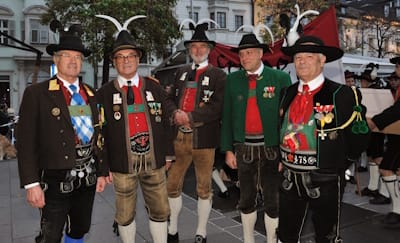
In 1983 McCarthy stopped his live performances and packed his props into six closed trunks. He turned his trunks - which always remained closed - into a sculpture, The Trunks (1984), which he presented at several exhibitions. At this stage in his career McCarthy failed to find any collectors for his work. Having also become a father, he turned to construction work to support his family, before taking up a teaching post in performance, video, installation, and art history in the pioneering New Genres Department at the University of California, Los Angeles (UCLA). In 1987 he produced Bavarian Kick, McCarthy's first mechanized sculpture. It consists of two metal figures in traditional Tyrolean costume, each raising a large jug of beer. This simple repetition of movement took on an autobiographical element in the way it represented McCarthy's feeling that his live performances had become mechanical in their monotony.
Mature Period
McCarthy's career breakthrough as an artist came in 1991, at the age of forty-five, having participated in a group exhibition of Los Angeles artists, Helter Skelter, at The Museum of Contemporary Art, Los Angeles (MoCA). MoCA's publicized its exhibition thus: "Helter Skelter: L.A. Art in the 1990s, featuring works by 16 visual artists and 10 writers from the Los Angeles area, considers the narratives created in the long shadows cast by the harsh Southern California light. The artists span different generations, backgrounds, disciplines, and formal practices, but the works presented [...] share a common vision in which alienation, dispossession, perversity, sex, and violence either dominate the landscape or form disruptive undercurrents".
Helter Skelter provided the platform for McCarthy to unveil his infamous installation, Garden. Using disused sets from the 1960s American TV series Bonanza, it features an elevated cluster of trees and rocks but, on close inspection, viewers discover the mechanical figures of a father and son are engaged in perverse sexual acts (with a tree and the earth respectively) that allude to the idea of "nature being raped" by man and machines. New York's New Museum said of the work: "Left by themselves in a wilderness that is implicitly understood as a fragment of paradise, the figures defile both the landscape and the sacred bond between generations. Not only has McCarthy ventured into the highly charged terrain of interfamilial sexuality in this work, he also makes us uncomfortably aware of our corporeal relationship to the father and son figures". The work's unsavory subject matter did not put off the influential American curator and art dealer Jeffrey Deitch who acquired Garden, and by so doing, effectively thrusted McCarthy under the spotlight of the contemporary art world.
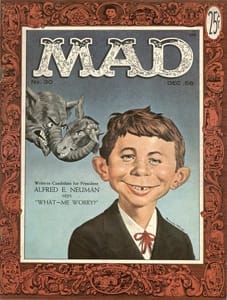
On the back of the Garden success, MacCarthy produced Bossy Burger (1991). It would become a milestone in 1990s Installation and Performance art. In the video of the performance, McCarthy, who appears to be unknowingly trapped inside the set (he used discarded stage sets from the television sitcom Family Affair) assumes the role of a puerile fool, as he hosts a children's educational television show. At various points, McCarthy wears a chef's outfit, oversized clown shoes, and a mask of Alfred E. Neuman (the "mascot" for Mad, a magazine known for its sharp and humorous take on popular culture and politics). Bossy Burger presented a two-pronged attack on fast food culture and the corrupting influence of children's television. Also in 1991, McCarthy finally opened up his trunks (sealed since 1983) and photographed their contents (including rubber masks, ketchup and mayonnaise jars, toys, knives, kitchen utensils, and disfigured dolls). The photographs were then presented in a collection titled PROPO.
McCarthy reputation soared through a series of distorted and darkly comedic pieces that parodied popular icons including Disney characters, Hollywood celebrities, and corporate mascots. Sculptures, such as Spaghetti Man (1993), Mutant (1994), Pinocchio Pipenose Householddilemma (1994) and Tomato Head (1994), tapped into (what he saw as) the absurd artifice and hypocrisy of American popular culture. The art critic Jonathan Jones, put McCarthy's popularity at this time down to a "renewed artistic obsession with the body, decay, and mortality". Apple Heads on Swiss Cheese (1997-99), meanwhile, was based on toys and teddy bears and offered ironic commentaries on modern childhood.
Late Period
Moving into the new millennium, McCarthy pushed the boundaries of spectacle and immersive environments, creating oversized, theatrical installations that engulfed the viewer in chaotic, dystopian worlds. In a 2001 work titled Boxhead, for instance, McCarthy presented his audience with a grotesque figure with cartoonish limbs. The lower half of the sculpture is exaggerated in a manner that recalls both Disney iconography and large floating inflatable figures. Its block-like head encloses the central figure's identity and replaces recognizable facial features with an impersonal, machine-made form. The protruding rod on the side suggest an industrial or mechanized function, further stripping the figure of any personality. The overriding theme of dehumanization and distortion reflect McCarthy's concerns with the mass media's impact on the corruption of childhood innocence, and the artificiality of commercial imagery.
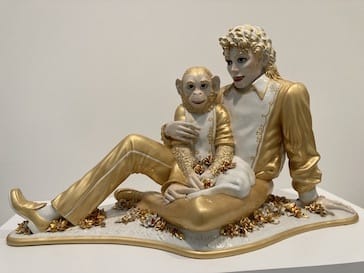
In 2002, and in keeping with his interest in the theme of tarnished childhoods, McCarthy turned his attention to the troubled pop superstar, Michael Jackson. He created his own bronze version of Jeff Koons's famous porcelain sculpture, Michael Jackson and Bubbles (1988). Commenting on, Michael Jackson Fucked Up Big Head (Carbon Fiber Blue), Christies auction house said the following: "Countering the refined connotations of the metal [bronze], the undifferentiated features of the faces differentiate McCarthy's portraiture from the excess of the baroque rendering of [Koons's] inspiration. [...] Jackson dedicated much of his life to regaining an imagined innocence. He built Neverland Ranch, his private amusement park named for the island in the Peter Pan stories where children never grow up, in order to live out this utopian dream, which has turned into a nightmare in light of the allegations of his sexual proclivities". (In 2024, McCarthy told an audience, "I tried to buy Neverland [Jackson's home/amusement park] I came close. That was the work - to buy Neverland".)
His 2003 installation Blockhead, a massive inflatable sculpture of a distorted Pinocchio, was displayed in London's Tate Modern, signaling his growing institutional acceptance. Also in 2003, McCarthy's presented his film (originally shot in his Los Angeles studio), Bunker Basement (2003), as an installation. The set was a replica of a bank's vault occupied by figures such as Osama bin Ladin, wearing a turban that resembles New York's Guggenheim Museum, Queen Elizabeth II's mother (the Queen Mother) with a pink globe for a head, and George W. Bush. The occupants engage in a childish spat leading to fully-blown food fight.
2005 saw the culmination of four years' work by McCarthy, and his son, Damon, on their Caribbean Pirates project. Taking its lead from the popular Disneyland ride and movie franchise Pirates of the Caribbean, the project consists of three installations, comprised of drawings, sculptures, photographs, and hours of recorded performance. Historian John C. Welchman writes, "Caribbean Pirates is staged as a visceral exploration of 'men on ships, alone,' interspersed with seething correlates transacted on shifting strips of terra firma. Completed in 2005, at the beginning of George W. Bush's second presidential term - and in the shadow of the war in Iraq launched two years earlier - the work allegorizes the destruction, plunder, and collateral damage of power at arms, and ironizes the rationales and justifications of remote violence". Welchman suggest, furthermore, that Caribbean Pirates belongs to "the web of nautical imagery" that can be traced back to the works of "historical avant-garde artists such as Vladimir Tatlin and Pablo Picasso". He writes, "while Picasso's study for a sex-seeking sailor was finally ushered off the stage of the brothel scene represented in Les Demoiselles d'Avignon (1907), it is clear from the hectic libidinal discharge of the McCarthys' Caribbean Pirates that the erotic urge and motivational latency of this iconic seafaring figure have not been forgotten".
In 2007 McCarthy and his daughter, Mara, opened The Box LA, with Mara taking on the role of Principal/Curator. The pair wanted to create an exhibition platform for LA artists who would have otherwise been ignored. Initially location in the Chinatown district (its current home in the Arts District in Downtown LA) the Box gallery held exhibitions for artists working in performance, installation, dance, drawing, painting, sculpture and video and photography. According to its own publicity, "The gallery recognizes the role of the art market as a means for artists to enter or re-enter art histories, and balances commercial interests against the cultural, political, psychological and spiritual content that the work may offer".
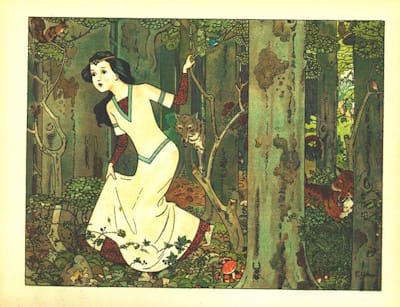
In 2012 McCarthy embarked on his ambitious WS, White Snow project, a reinterpretation of the German folktale, Schneewittchen (Snow White), and Walt Disney's animated classic animated film from 1937. McCarthy's take on the story features hypersexualized and violent depictions of its characters. These works featured performance, film and sculpture, creating immersive, psychologically intense experiences that carried forward his ongoing critique of capitalism, media manipulation, and the veneer of American innocence. Housed initially in a LA warehouse, and exhibited at New York's Park Avenue Armory (in 2013), WS White Snow featured a 8,800-square-foot artificial forest in which McCarthy has built a faithful three quarter scale replica of his childhood home in Salt Lake City. Projected next to the installation was a 7 hour four-channel mural-size video projection, edited by his son, Damon, and featuring performances filmed over 30 hours. In the film McCarthy plays an amalgam of Walt Disney and Hitler and engages in an orgy with Snow White and her dwarves.
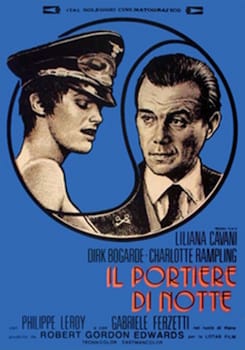
In 2014 McCarthy produced one of his most controversial sculptures, Tree, a green inflatable that unambiguously resembles a "butt plug" sex aid. The work was defaced (and removed) after just two days after its installation in Place Vendôme, Paris. In 2016 McCarthy separately exhibited his White Snow Wood Sculptures at Seattle's Henry Art Gallery. The sculptures ranged in height from three to fourteen feet. As the museum explains, "For these works, the artist turned to computer mapping to digitally scale, shape, and manipulate the final wood sculptures. The resulting pieces are recomposed, and sometimes grotesque, variations of familiar characters from the classic tale, such as the Prince, Dopey, and Snow White herself".
Also in 2016, McCarthy teamed up with the German stage actress Lilith Stangenberg on Rebel Dabble Babble, a video installation based on the 1955 movie, Rebel Without a Cause. Three years later they worked on NV Night Vater, a film by McCarthy and his son, Damon, inspired by the controversial 1974 film, The Night Porter. McCarthy portrays a fascistic Hollywood executive and Stangenberg a young actress, who engage in a sadomasochistic power relationship. The couple then agreed to work on a third project, A&E, through which they extended these themes in their dual roles of Adolf Hitler and Eva Braun and Adam and Eve. Despite the difficult nature of his work, McCarthy's status in the art world continued to rise, with exhibitions in prestigious institutions including the Whitney Museum of American Art, MoMA, and the Guggenheim confirming his status.
In his later years, McCarthy's work has become increasingly immersive and monumental, incorporating multi-room installations, elaborate film productions, and massive sculptures that tackle themes such as authoritarianism, celebrity culture and patriarchal power structures. Between 2016-17, McCarthy produced 20 feature-length chapters as part of his Coach Stage Stage Coach/Donald and Daisy Duck Adventure (CSSC/DADDA), multidisciplinary project. The chapters, which amounted to a meditation on mediated violence, featured figures such as Donald and Daisy Duck, their daughter Bonkers, Nancy Reagan, Andy Warhol and John Wayne. McCarthy said, "In DADDA I play Donald Trump or Donald Duck, and I'm an abusive buffoon, a drunken clown. In the video, people are being killed. There are no alliances - being killed, abused or beaten can happen to anyone by anyone. It's absurdity, a caricature. But I don't know how one tops the absurdity, buffoonery of Trump or what is happening now". Indeed, around this time McCarthy designed a set of 8 skateboard decks featuring offensive Trump caricatures based on his anti-Trump posters for the Women's March in January 2017. His decks, a further expression of his strong feelings towards Trump's presidency, were launched to mark the one-year anniversary of his inauguration (with all profits from the sales donated to charities).
The Legacy of Paul McCarthy
McCarthy's multifaceted artistic practice has seen him compared to other Los Angeles radicals including Allan Kaprow, Chris Burden, and Mike Kelley. Despite being fiercely provocative, not least for stretching the limitations of painting by using unorthodox materials such as bodily fluids and food, his art provides proof that even the most transgressive work can generate substantial market value. As art critic Jonathan Jones put it, "Perhaps the surprise, the thing to be explained, is not how [McCarthy] got ignored by the mainstream art world for so long but how he ended up rich and famous without once compromising or simplifying his disturbing, shocking, confrontational art".
McCarthy's visceral political and social satire is key to his impact on later generations. He constructs absurd, dystopian worlds, that invite his audiences to look at the decay beneath surface appearances. His art has offered inspiration to artists like Jake and Dinos Chapman, Matthew Barney and Nathaniel Mellors, all of whom have explored themes of media distortions, consumer excess and the body as a site of degradation and spectacle. Moreover, McCarthy is representative of the anarchic spirit of West Coast art and California's legacy to the 1960's counterculture movement. As Jones notes, "McCarthy is in the great tradition of Los Angeles art. He revels in the freedom, the quirky tolerance, of California. He is a survivor of the counterculture who defies the taboos and mocks the beliefs of mainstream American society".
Influences and Connections

-
![Larry Bell]() Larry Bell
Larry Bell ![Tony Oursler]() Tony Oursler
Tony Oursler- Jason Rhoades
- Paul Pfeiffer
- Cameron Jamie
-
![Jake and Dinos Chapman]() Jake and Dinos Chapman
Jake and Dinos Chapman - Jordan Wolfson
- Christoph Schlingensief
- Kembra Pfahler
- Thomas Hirschorn
- Paul Pfeiffer
- Nathalie Djurberg
- Hans Berg
- Ryan Trecartin
- Jonathan Meese
-
![Conceptual Art]() Conceptual Art
Conceptual Art -
![Installation Art]() Installation Art
Installation Art -
![Video Art]() Video Art
Video Art - Post-Internet Art
Useful Resources on Paul McCarthy
- Paul McCarthy - Revised and Expanded Edition (Phaidon Contemporary Artist Series)By Ralph Rugoff, Kristine Stiles , et al.
- Paul McCarthy: Head Space, Drawings 1963-2019By Aram Moshayedi, Connie Bulter, et al.
- Paul McCarthy: Caribbean PiratesBy Paul McCarthy, Damon McCarthy, John C. Welchman
- Pay for Your Pleasures: Mike Kelley, Paul McCarthy, Raymond PettibonBy Cary Levine
- Paul McCarthy: Dimensions of the MindBy Paul McCarthy, Eva Meyer-Hermann
 Ask The Art Story AI
Ask The Art Story AI